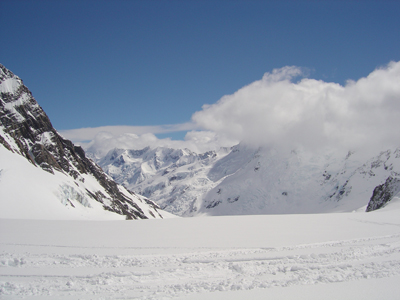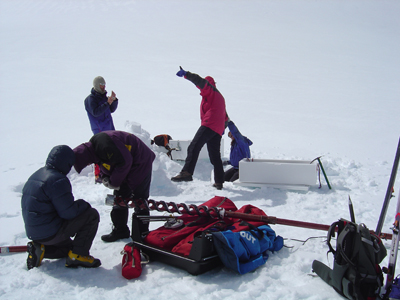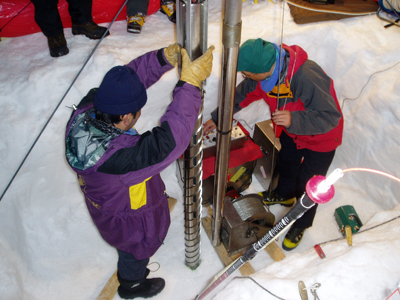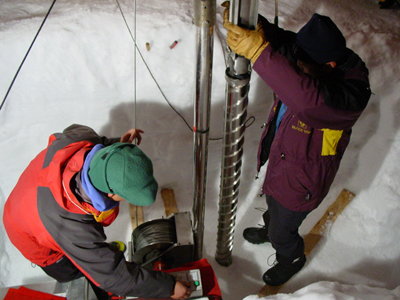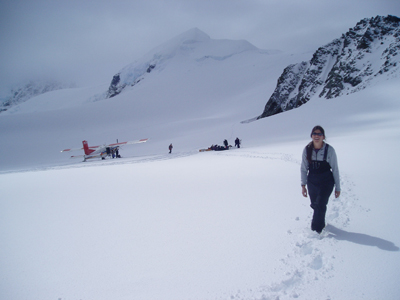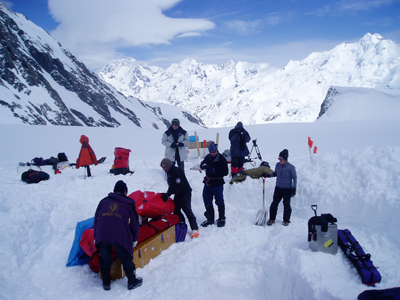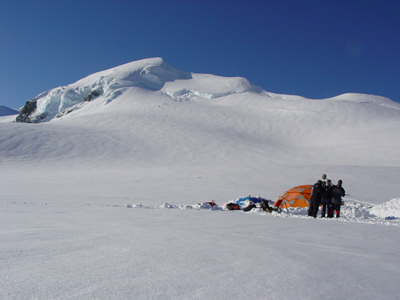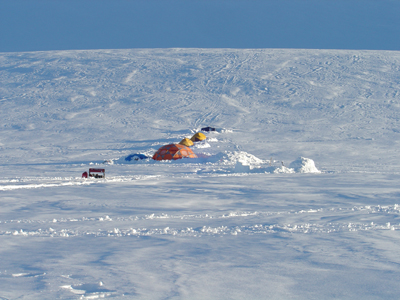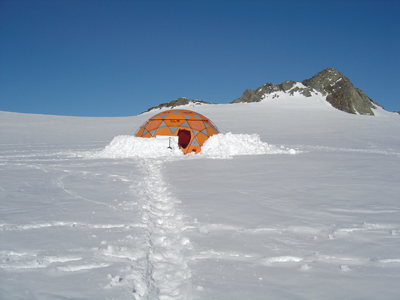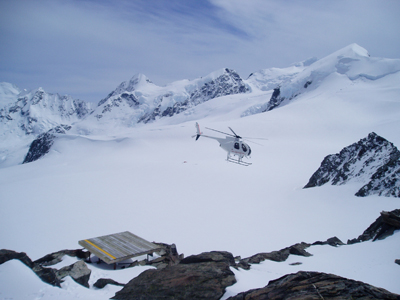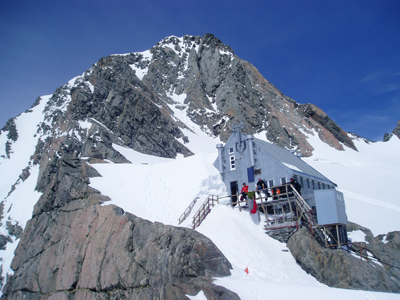
Ice Cores from the upper Tasman Glacier, New Zealand
Ice Cores from the upper Tasman Glacier, New Zealand
Paul Mayewski, Andrei Kurbatov, Sharon Sneed, and Susan Kaspari, UMaine
Use Morgenstern, Julian Thomson, Institute of Geology and Nuclear Sciences, Wellington, New Zealand
Shichang Kang and Zinsheng Gao, Institute of Tibetan Plateau Research, Chinese Academy of Sciences
Lisa Taylor, Dino Congonidis and Mike Ellis, Stonehaven Productions, Canada
October 12, 2004 – November 15, 2004
There are limited sites in the South Pacific from which high-resolution climate records can be collected. The objective of this expedition is to fill this gap by collecting ice cores from the Upper Tasman Glacier. Ice cores from this site will provide one of the longest (200-300 years) high-resolution Southern Hemisphere climate records between Antarctica and the Tropics, and calibrate and extend the instrumental record. Warming over the last century has caused a marked retreat of the glaciers in New Zealand’s Southern Alps. The Tasman Glacier ice core will help us to reconstruct changes in climate (temperature, precipitation and atmospheric circulation) over the last 200-300 years to improve our understanding of the factors affecting New Zealand’s climate, and the associations of New Zealand and Southern Hemisphere climate (e.g. El Niño Southern Oscillation (ENSO) and Interdecadal Pacific Oscillation (IPO)).
After waiting at Unwin Hut for only 2 days the weather cleared and we were able to fly to the site on Monday, October 18. The group is very international: Paul Mayewski, Andrei Kurbatov, Susan Kaspari, and Sharon Sneed (me) from UMaine; Uwe Morgenstern and Julian Thompson from New Zealand’s Geological and Nuclear Sciences Institute, Wellington; and Shichang Kang and Mr. Gao from the Chinese Academy of Sciences Cold and Arid Regions Science and Engineering Institute, Lanzhou, China. Also in the group was a film crew from Canada: Lisa Taylor, Dino Congonidis and Mike Ellis.
The site is located at the upper reaches of the Tasman Glacier, New Zealand’s largest, in Aoraki/Mt. Cook National park. There are no other mid-latitude glaciers in the Southern Hemisphere suitable for climate research – the hope is the record recovered from this site will fill in the blank for this part of the planet.
Monday afternoon and Tuesday were spent setting up camp and organizing gear. Camp was a geodesic dome drill tent and three small sleeping tents for some, the rest stayed at the nearby Kelman Hut – a short kilometer walk from the drill site. We collected the first core on Tuesday night. (Due to the relatively warm temperatures drilling started at about 8 pm and continued through the night.) The Chinese drill worked great and we reached 28 meters before hitting water. Glaciers can be either cold based or warm based and in temperate regions is not surprising to find water at the bottom of the ice.
Thursday night we drilled an exploratory core on a ridge about 75 meters away from site 1. Because of the presence of a cravasse at about 35 meters we moved the next drill site about 20 meters up the glacier. The core collected from that site on Friday night reached water at about 46 meters. Friday also brought the departure of Paul and the film crew.
Saturday and Sunday we rested (the weather was not good on Sunday) and celebrated Susan’s birthday. Because of the time and date difference between New Zealand and the States Susan was able to enjoy her birthday for almost 2 full days.
Monday we moved the drill tent once again and Monday night collected a 53 m core of really good quality. We are all looking forward to seeing the analytical results.
Tuesday we began to pack some of the gear. We were visited by a crew from New Zealand’s Channel One news and they filmed the drill in action Tuesday night. Wednesday brought great flying weather and we transported all the ice (and me) off the glacier. A refrigerated truck was pre-arranged to be at the airport to transport the ice, eventually to Wellington.
Kelman Hut is beautifully located on a ridge with views all around. It sleeps 20 so during our stay at least 3 other groups stayed for a few days and one group walked over from a near-by hut to be neighborly. Communications were made possible by satellite phones and hut radios. Daily at 7 pm the Department of Conservation radios the weather report and contacts all huts for a status report and delivers any messages. The weather is probably the single most important variable for exploring the region. Flying in and out of the glacier requires good visibility and light winds, a somewhat rare occurrance. Due to winds yesterday, snow today, and winds tomorrow we expect the rest of the team to fly off the glacier on Sunday and to return home mid-week.
This has been a successful and exciting experience. New Zealand is a beautiful country and we have all enjoyed our short stay in Christchurch and fascinating field trip on the glacier.



